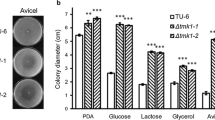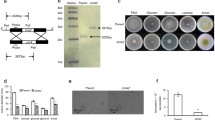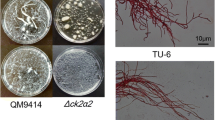Abstract
Protein kinases are key players in controlling many basic cellular processes in almost all the organisms via mediating signal transduction processes. In the present study, we characterized the cellulolytic Trichoderma reesei orthologs of Saccharomyces cerevisiae Sch9 and Yak1 by sequence alignment and functional analysis. The T. reesei Trsch9Δ and Tryak1Δ mutant strains displayed a decreased growth rate on different carbon sources and produced less conidia. The absence of these two kinases also resulted in different but abnormal polarized apical growth as well as sensitivity to various stresses. In addition, disruption of the genes Trsch9 or Tryak1 resulted in perturbation of cell wall integrity. Interestingly, while the induced production of cellulases was slightly compromised in the Trsch9Δ strain, the extracellular production of cellulases was significantly improved in the absence of Yak1. The results indicate that TrSch9 and TrYak1 play an important role in filamentous growth, stress response and induced production of cellulases in T. reesei.
Similar content being viewed by others
References
Bradford, M.M. 1976. A rapid and sensitive method for the quantitation of microgram quantities of protein utilizing the principle of protein-dye binding. Anal. Biochem. 72, 248–254.
Brown, N.A., de Gouvea, P.F., Krohn, N.G., Savoldi, M., and Goldman, G.H. 2013. Functional characterisation of the non-essential protein kinases and phosphatases regulating Aspergillus nidulans hydrolytic enzyme production. Biotechnol. Biofuels 6, 91.
Budovskaya, Y.V., Stephan, J.S., Deminoff, S.J., and Herman, P.K. 2005. An evolutionary proteomics approach identifies substrates of the cAMP-dependent protein kinase. Proc. Natl. Acad. Sci. USA 102, 13933–13938.
Fabrizio, P., Pozza, F., Pletcher, S.D., Gendron, C.M., and Longo, V.D. 2001. Regulation of longevity and stress resistance by Sch9 in yeast. Science 292, 288–290.
Garrett, S., Menold, M.M., and Broach, J.R. 1991. The Saccharomyces cerevisiae YAK1 gene encodes a protein kinase that is induced by arrest early in the cell cycle. Mol. Cell Biol. 11, 4045–4052.
Goyard, S., Knechtle, P., Chauvel, M., Mallet, A., Prevost, M.C., Proux, C., Coppee, J.Y., Schwartz, P., Dromer, F., Park, H., and et al. 2008. The Yak1 kinase is involved in the initiation and maintenance of hyphal growth in Candida albicans. Mol. Biol. Cell 19, 2251–2266.
Gruber, F., Visser, J., Kubicek, C., and de Graaff, L. 1990a. Cloning of the Trichoderma reesei pyrG gene and its use as a homologous marker for a high-frequency transformation system. Curr. Gen. 18, 447–451.
Gruber, F., Visser, J., Kubicek, C.P., and de Graaff, L.H. 1990b. The development of a heterologous transformation system for the cellulolytic fungus Trichoderma reesei based on a pyrG-negative mutant strain. Curr. Gen. 18, 71–76.
Hartley, A.D., Ward, M.P., and Garrett, S. 1994. The Yak1 protein kinase of Saccharomyces cerevisiae moderates thermotolerance and inhibits growth by an Sch9 protein kinase-independent mechanism. Genetics 136, 465–474.
Larkin, M.A., Blackshields, G., Brown, N.P., Chenna, R., McGettigan, P.A., McWilliam, H., Valentin, F., Wallace, I.M., Wilm, A., Lopez, R., et al. 2007. Clustal W and clustal X version 2.0. Bioinformatics 23, 2947–2948.
Lee, P., Cho, B.R., Joo, H.S., and Hahn, J.S. 2008. Yeast Yak1 kinase, a bridge between PKA and stress-responsive transcription factors, Hsf1 and Msn2/Msn4. Mol. Microbiol. 70, 882–895.
Lee, P., Paik, S.M., Shin, C.S., Huh, W.K., and Hahn, J.S. 2011. Regulation of yeast Yak1 kinase by PKA and autophosphorylationdependent 14-3-3 binding. Mol. Microbiol. 79, 633–646.
Lynd, L.R., van Zyl, W.H., McBride, J.E., and Laser, M. 2005. Consolidated bioprocessing of cellulosic biomass: an update. Curr. Opin. Biotechnol. 16, 577–583.
Lynd, L.R., Weimer, P.J., van Zyl, W.H., and Pretorius, I.S. 2002. Microbial cellulose utilization: Fundamentals and biotechnology. Microbiol. Mol. Biol. Rev. 66, 506–577.
Mandels, M. and Andreotti, R. 1978. Problems and challenges in the cellulose to cellulase fermentation. Proc. Biochem. 13, 6–13.
Morano, K.A. and Thiele, D.J. 1999. The Sch9 protein kinase regulates Hsp90 chaperone complex signal transduction activity in vivo. EMBO J. 18, 5953–5962.
Parija, S.C., Shivaprakash, M.R., and Jayakeerthi, S.R. 2003. Evaluation of lacto-phenol cotton blue (LPCB) for detection of Cryp-tosporidium, Cyclospora and Isospora in the wet mount preparation of stool. Acta Tropica 85, 349–354.
Pascual-Ahuir, A. and Proft, M. 2007. The Sch9 kinase is a chromatin-associated transcriptional activator of osmostress-responsive genes. EMBO J. 26, 3098–3108.
Penttilä, M., Nevalainen, H., Rättö, M., Salminen, E., and Knowles, J. 1987. A versatile transformation system for the cellulolytic filamentous fungus Trichoderma reesei. Gene 61, 155–164.
Ptacek, J., Devgan, G., Michaud, G., Zhu, H., Zhu, X., Fasolo, J., Guo, H., Jona, G., Breitkreutz, A., Sopko, R., et al. 2005. Global analysis of protein phosphorylation in yeast. Nature 438, 679–684.
Ram, A.F.J. and Klis, F.M. 2006. Identification of fungal cell wall mutants using susceptibility assays based on Calcofluor white and Congo red. Nat. Protocols 1, 2253–2256.
Roosen, J., Engelen, K., Marchal, K., Mathys, J., Griffioen, G., Cameroni, E., Thevelein, J.M., De Virgilio, C., De Moor, B., and Winderickx, J. 2005. PKA and Sch9 control a molecular switch important for the proper adaptation to nutrient availability. Mol. Microbiol. 55, 862–880.
Santangelo, G.M. 2006. Glucose signaling in Saccharomyces cerevisiae. Microbiol. Mol. Biol. Rev. 70, 253–282.
Schuster, A., Tisch, D., Seidl-Seiboth, V., Kubicek, C.P., and Schmoll, M. 2012. Roles of protein kinase a and adenylate cyclase in lightmodulated cellulase regulation in Trichoderma reesei. Appl. Environ. Microbiol. 78, 2168–2178.
Suwunnakorn, S., Cooper, C.R. Jr., Kummasook, A., and Vanittanakom, N. 2014. Role of the yakA gene in morphogenesis and stress response in Penicillium marneffei. Microbiology 160, 1929–1939.
Tamura, K., Peterson, D., Peterson, N., Stecher, G., Nei, M., and Kumar, S. 2011. MEGA5: Molecular evolutionary genetics analysis using maximum likelihood, evolutionary distance. and maximum parsimony methods. Mol. Biol. Evol. 28, 2731–2739.
Thevelein, J.M. and de Winde, J.H. 1999. Novel sensing mechanisms and targets for the cAMP-protein kinase A pathway in the yeast Saccharomyces cerevisiae. Mol. Microbiol. 33, 904–918.
Toda, T., Cameron, S., Sass, P., and Wigler, M. 1988. SCH9, a gene of Saccharomyces cerevisiae that encodes a protein distinct from, but functionally and structurally related to, cAMP-dependent protein kinase catalytic subunits. Genes Development 2, 517–527.
Urban, J., Soulard, A., Huber, A., Lippman, S., Mukhopadhyay, D., Deloche, O., Wanke, V., Anrather, D., Ammerer, G., Riezman, H., et al. 2007. Sch9 is a major target of TORC1 in Saccharomyces cerevisiae. Mol. Cell 26, 663–674.
Author information
Authors and Affiliations
Corresponding author
Additional information
These authors contributed equally to this work.
Rights and permissions
About this article
Cite this article
Lv, X., Zhang, W., Chen, G. et al. Trichoderma reesei Sch9 and Yak1 regulate vegetative growth, conidiation, and stress response and induced cellulase production. J Microbiol. 53, 236–242 (2015). https://doi.org/10.1007/s12275-015-4639-x
Received:
Revised:
Accepted:
Published:
Issue Date:
DOI: https://doi.org/10.1007/s12275-015-4639-x




